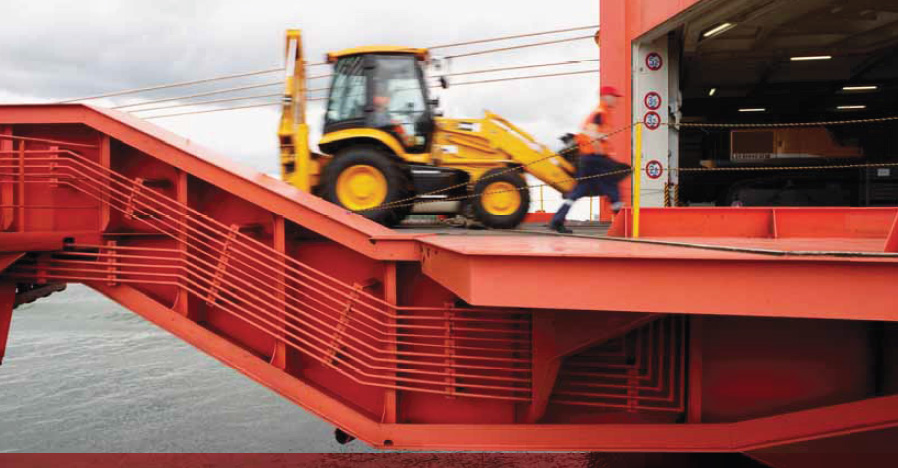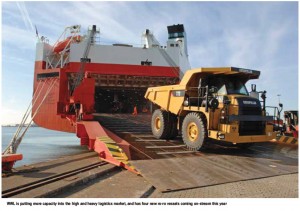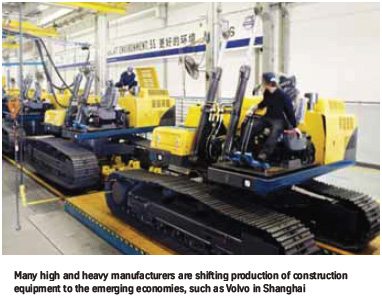
The high and heavy industry is recovering, but the growth is now in emerging economies and the logistics sector needs to invest or shift capacity to service the demanding new markets, writes Andrew Williams.
During the recent downturn, companies in the high and heavy sector experienced a sharp drop in sales, exacerbated by a continued stagnation in the construction industry. Many in the sector now anticipate some form of modest recovery and are preparing to scale up production.
So, what are the prospects for the sector over the next year or two? In particular, what is the current trajectory and outlook for commercial vehicles and construction equipment in terms of demand, sales and production–and how well placed is the global logistics sector to adapt? Also, to what extent will changing freight rates, new market opportunities and a heightened awareness of environmental issues influence mid- to long-term strategies?
Construction back on track?
“The construction equipment industry has recovered quite well both in terms of volume but also when it comes to reducing inventory,” explains Stefan Nilsson of Volvo Construction Equipment.
inventory,” explains Stefan Nilsson of Volvo Construction Equipment.
“Our indicators tell us that demand will keep growing during 2011 and likely also in 2012 for most markets,” he adds. However, some predict that the exact scale of the increase is likely to vary widely from region to region. In developed markets, a modest growth of around 5-10% from low levels is widely expected. However, the picture is complicated by a sluggish housing market, as well as high debt levels and a legacy of overspending during the last economic cycle, which is likely to have a moderating effect on demand. This single digit expansion will be dwarfed by a growth in China and other emerging economies, according to John Deere’s David Panjwani.
“Some markets [will increase] dramatically. The upturn will have the largest gains in emerging markets such as China, India and Brazil,” he predicts.
“The post-crisis economic growth is, and will be, driven largely by many emerging countries with large populations and all types of underdeveloped infrastructure,” says Kai Krass.
“We expect to continue to leverage our global network of ocean routes, terminal facilities, and technical services, to please current customers and attract new customers, regardless of the actual rate of economic growth,” he adds.
Are the LSPs ready? A certain degree of regional variability is also anticipated in terms of how well placed the logistics sector is to react to the anticipated upturn. Some commentators, particularly in Europe, are confident that logistics capacity will in general be much better utilised, particularly in view of the fact the sector is returning from very depressed levels. “Most carriers are not back to the capacity they had in place in 2007-2008, [while] some reduced capacity to bring operational costs down and turn loss into profit last year,” says Frank Fleury.
A certain degree of regional variability is also anticipated in terms of how well placed the logistics sector is to react to the anticipated upturn. Some commentators, particularly in Europe, are confident that logistics capacity will in general be much better utilised, particularly in view of the fact the sector is returning from very depressed levels. “Most carriers are not back to the capacity they had in place in 2007-2008, [while] some reduced capacity to bring operational costs down and turn loss into profit last year,” says Frank Fleury.
“However, we do anticipate capacity constraints in 2011- 2012 during peak times,” he adds. Joannes Van Osta at JCB is also under the impression that carriers are managing capacity very tightly–in some market segments more than in others–either by taking out existing equipment or vessels or by reducing capacity by slow steaming.
“This allows the carriers to manage supply and demand and tends to influence pricing substantially. The question is whether this is a good and acceptable business practice in a global competitive market,” he says. Having already seen under-capacity in some trade lanes, Nilsson is of the opinion that there will probably be room for the logistics sector to grow.
“Creative solutions to reduce lead-time and cut costs but also...add value to our products and processes can build very successful companies in the logistics sector,” he says. Outside Europe, the picture is less certain. Panjwani claims that North American capacity for specialised equipment is very tight and predicted to remain a major challenge. “In other markets outside Europe there is also a similar challenge with regard to truck capacity. At this point ro-ro and break-bulk capacity is generally sufficient,” he says. “Port space will be an issue. It depends on what the land is worth. If it’s more advantageous to utilise the land for OEM traffic then that’s what we’ll do,” explains Steven Rand of Amports.
Fleury also points to an unbalanced trade in ocean freight, which is creating headaches for shipping lines–in particular, container lanes going full out of China and India to be returned empty.
Coping with growth
So, how best should the logistics sector react to the anticipated upturn? For Panjwani, this is a delicate question because in the last severe downturn excess capacity damaged the sector. “I think it is best for the industry for major shippers to form long-term and mutually beneficial partnerships with key logistics service providers. This cannot eliminate the inherent risks but can encourage investments to be maintained so that in market upturns capacity can be increased,” he says. If demand was stronger than expected others say that the best reaction from the logistics sector would be to bring back laid off trucks and idled vessels.
“Like us, [the logistics sector] is waiting to see a real growth. The sudden rise of commodities like oil, iron ore, copper, wheat, cotton to 2008 levels is probably frightening everybody at the minute and the logistics sector will not bring back capacity unless [it is] convinced that increases in demand are there for good,” says Fleury.
Freight rates climb
Following a brief period of rate decreases throughout the last quarter of 2008, and all of 2009, market freight rates have been gradually rising and are largely predicted to rise even more throughout 2011-2012 as demand outstrips capacity. “We don’t control freight rates. However, if market demand picks up I’m sure the carriers will extract their pound of flesh,” says Rand.
been gradually rising and are largely predicted to rise even more throughout 2011-2012 as demand outstrips capacity. “We don’t control freight rates. However, if market demand picks up I’m sure the carriers will extract their pound of flesh,” says Rand.
into medium- or long-term agreements with carriers to secure capacity and rates will see a rate increase of 10% or more within the next two years.
“Unless this rise in commodity prices is a new bubble which will explode, we do not anticipate a rate decrease,” he adds. According to Panjwani, there is also a danger that rate rises will have a negative impact on the end customer, who in many cases will ultimately absorb the increases.
“In some situations this will prove untenable,” he argues. Against this general anticipation of rate rises it is also important to bear in mind that, although in the minority, some observers are expecting prices to drop from the current level overall. However, even they accept that there may be specific pockets or market segments that will experience an increase in rates. “Since logistics cost is part of our total cost-to-market, this may have an impact on our distribution strategy,” says Van Osta.
Moreover, it is also possible that the more efficient use of transport capacity will help to push the cost down–although increasing fuel prices may well have the opposite effect. “We are seeing logistics providers from emerging markets that are willing to compete more on a global market. The global competition will probably push costs down in some parts of the sector,” says Nilsson.
From the carrier’s perspective, Krass points out that, in addition to supply and demand, there are other factors that will influence rates, such as increasing costs related to new legislative environmental mandates, escalating fuel costs and new-build costs. WWL is anticipating some changes on the supply side, including extensive recycling of old tonnage, and a slow but steady replacement with new builds. “For example, this year alone, WWL will take on four new ro-ro vessels–the world’s largest but also the most efficient,” says Krass.
“We can carry 10% more cargo while improving fuel efficiency by up to 15%, which is important as fuel expense keeps going up and up and up,” he adds.
Productions shifts to follow sales
In common with many other sectors of the global economy, there is a growing consensus that over the next few years the most significant market opportunities will exist in emerging economies.
Vehicle manufacturers are continuing to make substantial investments in new production capacity and manufacturing facilities in the BRIC countries, which are identified as key markets for long-term demand growth. India also looks set to assume increasing importance as a global centre of production.
“We already see a new and growing demand from China and a growing production from India,” says Fleury. “During the global downturn we had to rethink the way we were marketing and selling our machines. We increased sales in China and India and decided to shift production of certain models from Brazil to India,” he adds.
There is also some evidence that producers are gearing up for anticipated growth in new markets outside BRIC countries. “We will continue to see growth in China, India, Brazil and Russia but can also prepare for the next generation of growth sectors in such places as sub-Saharan Africa, CIS countries and Indonesia,” says Panjwani.
To take full advantage of these new opportunities, both the logistics sector and the vehicle producers must develop cohesive plans for the BRIC countries. In view of the fact that more and more finished vehicles will be produced in these markets there is a growing awareness of the need to develop adequate logistics networks.
“Currently, with India and China there are limited but growing logistics networks for the high and heavy sector. We are confident our partners will come up with solutions soon, so that we have new calls, at ports closer to our customers, thus reducing lead time and logistics costs,” says Fleury. According to Panjwani, this type of new growth must also be supported by new ro-ro ocean shipping lanes, investment in specialised trailers and truck capacity, as well as the evolution of a rail infrastructure that can focus on and support heavy machinery.
Also on the technical side, Nilsson explains that there have been some interesting solutions facilitating high and heavy transport on container vessels by developing traditional flatbed and flatracks. “When these solutions mature they could open up some very interesting opportunities for high and heavy vehicles,” he says.
As OEMs continue to search for ways of improving quality while lowering distribution costs, Krass anticipates that many high and heavy OEMs will look for more holistic outbound supply solutions that enable them to make large, strategic improvements.
“In short, we think that high and heavy manufacturers will start to look for [the] benefits of network optimisation, supply chain management and industrialisation processes, [in] much the [same] way [that] automakers have been doing,” he says. In an effort to service these new markets, Krass explains that WWL is investing over $1 billion in state-of-the art vessels. Six large car truck carriers (LCTCs) and four Mark Vs are being delivered during 2011-12, which will enable WWL to carry heavier cargo, and more of it, so it can cater to high and heavy customers’ needs.
“We have also invested heavily in building a global network of 11 high and heavy processing and distribution centres, so we anticipate that we are positioned to give our customers access to growing markets wherever they may be...but we have become experts at responding to market forces and developing capacity quickly,” he adds.
Environment legislation kicks in
Environmental regulations, in particular those governing CO2 emissions, are likely to continue to affect many trade areas, including high and heavy. However, when co-ordinated and implemented well, there is a general acceptance in the industry that, as well as reducing total emissions from the logistics sector, such regulations can also provide an important impetus for companies to drive down costs. “I believe that the logistics providers that have been successful in fuel efficiency investments will have a considerable competitive advantage over the years to come,” says Nilsson.
Another key trend in road transport is the general move towards permitting longer and heavier trucks. For some, having longer trucks can only help in reducing the number of trucks on the road. “It would also benefit high and heavy as we could optimise our loads,” says Fleury.
“Longer trucks have already reduced cost and environmental impact for our inbound logistics,” adds Nilsson. An increased awareness of environmental impacts is also pushing some companies to evaluate alternative methods of moving machinery.
“This may include increased use of rail where possible, as well as the shipping of units in components and performing re-assembly closer to customer destination and aligning with logistics providers that meet and exceed current and future requirements,” says Panjwani. AGCO are experimenting with the use of barges in canals and rivers on the approach to the main European sea ports.
“We are hopeful that we will develop new infrastructure to help us reduce impacts before [incurring] ‘environmental penalties.’ We are very hopeful that the Paris-North Europe canal will see the light one day,” says Fleury.
In the shipping sector, Krass anticipates that a raft of environmental regulations will impact the shipping sector over the next five years. When combined with rising energy costs, this is likely to cause significant cost and risk impacts in the outbound supply chain.
“Tackling this future requires OEMs to adopt new strategies, for example adding emissions as an optimisation criteria alongside time, cost and quality, enables manufacturers to potentially reduce both emissions and costs in the supply chain,” he says.
For Van Osta, although every regulation that limits the industry’s freedom to move machines will of course be felt as a limiting factor, the increased awareness of environmental impacts will also help in fostering new opportunities. “Saving carbon means saving on cost in most cases, although not always,” he says. “[Such] a sustainable model should be the drive for all involved. [Not just] for those who set the rules, but also for those who operate the network,” he adds.
In summary, the high and heavy sector looks set to experience a period of growth over at least the next year or two. Although the prospects for developed markets look a lot better than they did a year or so ago, the vast majority of the increase in demand, sales and production is widely expected to occur in emerging economies, particularly Brazil, Russia, India and China.
In view of the changing complexion of the global high and heavy market, the logistics sector now faces a major challenge in ramping up capacity and developing the transport infrastructure necessary to service these new markets. More generally, it must also seek new ways navigating this shifting landscape in a profitable manner whilst simultaneously adapting to ever more stringent environmental requirements.


























![Global[1]](https://d3n5uof8vony13.cloudfront.net/Pictures/web/a/d/s/global1_726550.svgz)









